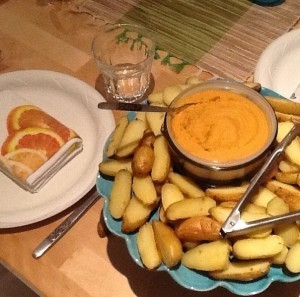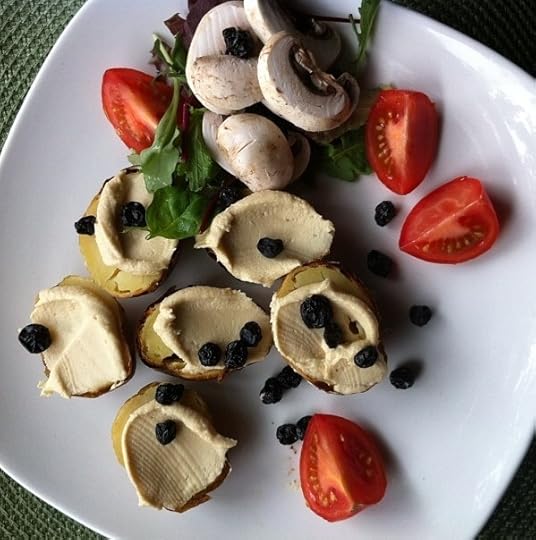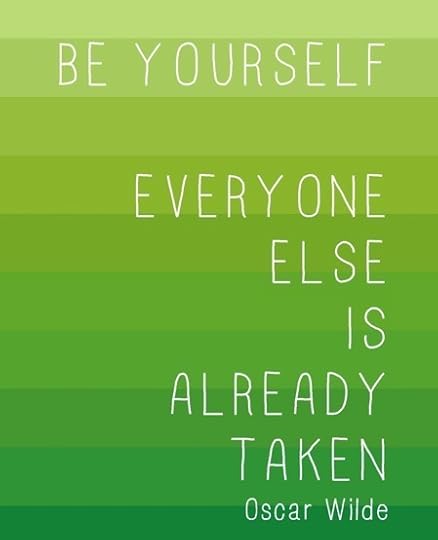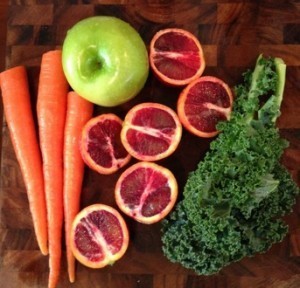Rip Esselstyn's Blog, page 24
August 22, 2014
Carrot Kale Muffins
Start your day with these hearty muffins! A slight sweetness from the carrots, raisins and spices makes a great pairing with the kale and the cornmeal.
Carrot Kale Muffins
Preheat oven to 400 degrees
1 carrot shredded
8 oz – pureed carrots (puree yourself or substitute 2 – 4oz jars of baby food carrots)
1 teaspoon – pumpkin pie spice
1 teaspoon – cinnamon
2 tablespoons – honey (or maple syrup)
1 teaspoon – vanilla extract
1/2 cup finely diced lacinato kale
3/4 cup – hot pumpkin spice brewed tea or rooibos chai tea
3/4 cup – unsweetened almond milk
2 cups – whole wheat pastry flour
1 teaspoon – baking powder
1 teaspoon – baking soda
1/2 cup – corn meal
1 tablespoon – flax meal
4 oz – raisins
2 tablespoons rolled oats for sprinkling on muffin tops
Shred carrot into bowl.
Add pureed carrots, spices, extract, kale and hot brewed tea
Let bowl sit for 3 minutes for kale to soften
Stir mixture while adding the almond milk.
In a separate bowl, mix dry ingredients and raisins saving the oats for later
Combine wet and dry ingredients just until well mixed
Fill parchment muffin liners with batter until nearly full 1/8” from top
Sprinkle rolled oats on the top of muffins
Makes 12 muffins
Bake for 30-35 minutes, let cool for 10-15 minutes on a rack before eating.
No related posts.
August 20, 2014
Summer’s End
If you’re a teacher, the summer really ends the first week of August. As a former teacher, I always looked forward to the return of school because it meant the beginning of a steady routine, both in my home and the classroom. And, it also meant lots of great discussions in the Teachers’ Lounge.
I often think about how much I would love to be in the classroom again, but mainly for two reasons. Meatless Mondays and something I’d call Fruity Fridays.
As Meatless Mondays become more popular, working with your teacher base might be a good way to implement a no-meat policy once a week at your school.
Here are a few thoughts that might help to bring more veggies and fruits to your local school:
-Along with your school administrator, implement a “No Meat Monday” for teachers. Start behind the scenes to empower your co-workers with the benefits of eating plants. Bring in some recipes–there are some great ones on Engine 2 that would ignite everyone’s interest in eating better. Better than that, bring in your favorite E2 dish and serve it in the teachers’ lounge…they will love you!
-Work with your PTO. I often marveled at the ability that the PTO had in helping to mobilize a thought or concept. An all grade veggie potluck might be a fun way to start!
-Offer a challenge to your school head or principal. Try Meatless Mondays for four weeks! I once saw a principal sit on the roof of my children’s school because the student body read more than 1000 books. Everyone loves a challenge, or new opportunity.
-Fruity Friday is a fun way to talk about the benefits of fruit. See if a local grocer or produce store can donate fruit to your school or classroom. Students will love having fresh fruit.
-Lastly, great resources abound at http://www.pcrm.org The Physician’s Committee for Responsible Medicine is really everyone’s go-to organization for learning about ways to implement a meatless monday in your school. Its head, Neal D. Barnard, MD is a good friend to Engine 2, and we often turn to his group for guidance.
As you return to school, have a get-together with fellow teachers. You can easily come up with a master-minded plan to serve as good, plant-based examples for your students.
And, there’s always that one parent who wants to help. Make Meatless Monday seem like a trendy event, and you will see how people want to feel better while following a plant-strong diet, if even only for one day a week.
But, it’s a great way to start.
Be the change in this school year by eating lots of plant-based, whole foods. The next thing you know, that one day per week program, may become the new, daily, norm.
Plant-strong!
No related posts.
August 13, 2014
Smokey Cheez Sauce
1 can reduced sodium cannellini beans with liquid
4 tablespoons nutritional yeast
3 tablespoons Ninja Squirrel Sriracha Sauce – or other brand if not available
1 tablespoon corn starch
1 tablespoon lime juice
1 teaspoon cumin
1 teaspoon smoked paprika
Blend in a blender or food processor until smooth.
Serve over brown rice and steamed vegetables, on tacos, in burritos, on baked potatoes – use your imagination!
No related posts.
August 7, 2014
Plant-Strong Kids Week 8
This week is all about lunch! We have lunchbox ideas and tips plus a bunch of plant-strong lunch recipes!
If your child/children have completed ALL 8 weeks we have an easy-to-print certificate for them!
It is hard to believe that we are in the last week of our kids series! We want to thank everyone who contributed:
Dreena from Plant-Powered Kitchen
and Carson Sharp for her incredible art work!
Catch up with weeks 1-7:
We hope you enjoyed our kids series!
No related posts.
August 1, 2014
Praise the Potato
For a long time, potatoes have gotten a bad rap and mainly because they’ve either been fried, or slathered in fattening dairy. But, the reality is that potatoes pack a punch…loaded with potassium, fiber and Vitamin C., you can’t go wrong with a delicious, baked potato. They are very versatile and are a great grab-and-go snack, especially when they’re oven-roasted Fingerlings, my favorite. Fingerlings cook quickly, taste a tad sweeter than most other potatoes, and look pretty.
The versatility of the potato goes on for days and days. Here is a list of “Quick Ten” recipes that you can use to enhance any plant-strong dinner. Before you begin, get a five-pound bag of your favorite tuber and bake them all at once, this way you will have a stash to use for various meals and snacks.
Here we go…
1. Simple snack. Throw a cooked, plain potato in your back-pack. When you are hungry, you’ve got the perfect snack to keep you going throughout the day. They are the perfect post-workout snack. Better than an energy bar, for sure!
2. Potato “Taboulleh.” While most of us think of taboulleh as a grain based dish, take two-three cooked potatoes and press them through a potato “ricer.” Add parsley, chopped tomatoes, mint, cucumbers, and lemon juice, gently mix, and you have a new spin on potatoes. Serve chilled.
3. Use potatoes as a thickener in any soup. Puree a cooked potato with one cup of broth. Add to large pot of soup, and the creaminess will appear.
4. Oven fries are a plant-strong staple. Cut them into strips. Place on a lined baking pan, season, and bake at 375 until golden brown. These will taste as good as any fries you’ve ever had. Really. (A sil-pat is the perfect liner)
5. Mash potatoes! Use four cooked potatoes, add plant-based milk (unsweetened), nutritional yeast, garlic powder and black pepper. These will taste so creamy!
6. Add some zing to your crudite platter. Move over carrot sticks, potato wedges are the new “must-have” for the veggie platter.
7. Make your own potato chips. Slice raw potatoes in the food processor so that you have “thin” potatoes. Bake in a 375 pre-heated oven. They will get super crispy and everyone will love them. Season with garlic powder. (NOTE: you can use a “microwave” dehydrator, and in minutes, you will have delicious chips.)
8. For dessert, sweet potato pudding is a favorite. Use a large baked sweet potato, peel it, add to your blender with a quarter-cup of your favorite plant-based milk. Add two dates and a dash of cinnamon. Blender until smooth and silky. Garnish with fresh berries. Makes enough pudding for three hungry dessert lovers!
9. The “new” soup bowl is actually a baked potato! Take a large baked potato, cut down the center, squeeze open, and cover with chili or soup. Can also be a “salad bowl.” We love edible bowls.
10. We all love potato salad, but an easy-peasy version is to use fat-free hummus in your potato salad. Adds flavor and takes minutes to make. Garnish with chopped parsley.
Give potatoes a new lease on life. Recognize them as the NEW kitchen staple in your plant-strong kitchen. Oh, and don’t forget, one potato has 4.3 grams of protein.
The next time someone asks, “But, where do you get your protein?” Just point to your delicious potato!
No related posts.
July 30, 2014
Plant-Strong™ Kids Week 7
It is hard to believe that we are in week 7 of our plant-strong™ kids series!
This week we have recipes from Happy Herbivore and Straight-Up Food.
Let us know how your kids are doing! We’d love to see some photos of your children and some of your activities or coloring pages.
No related posts.
July 29, 2014
Spotlight on Weight
Of all the health topics swirling around in American society and media today, weight captures more attention than almost any other issue. Currently, obesity is considered to be epidemic in our country, with childhood obesity rates more than doubling over the past 30 years (and with adolescent obesity rates quadrupling). In 2012, more than one third of Americans, both children and adults, were overweight or obese. There is no question that weight has become an issue worth addressing. However, I’ve learned that it is often addressed in ways that do not solve the problem or help people in the long term. Although there is merit to the concerns surrounding overweight and obesity, it can also be dangerous to focus on weight as a determinant of health.
Being overweight or obese puts people at higher risk for disease. According to the National Institutes of Health (NIH), people who are overweight have a greater chance of experiencing heart disease, stroke, high cholesterol, hypertension, type 2 diabetes, gallstones, sleep apnea, certain cancers, and joint problems. These associations are well documented and are important to take into consideration.
The fact that overweight promotes diseases makes sense when one considers the toll that excess weight takes on the body. For example, being overweight puts more stress on the weight-bearing joints because they must carry the extra weight of the body. Similarly, added weight of the chest wall squeezes the lungs and restricts the ability to breathe, which is what causes sleep apnea. Excess fat also brings about oxidative stress, a state of inflammation and imbalance between free radical production and antioxidant defenses. Being overweight also causes the body to need to work harder in general, increasing the effort that it takes to circulate blood or do physical activity.
Cardiovascular disease is perhaps the condition most commonly associated with overweight and obesity. People who are overweight or obese tend to have higher blood pressure, higher triglycerides, and higher cholesterol, all of which lead to atherosclerosis (hardening of the arteries) and cardiac events. As mentioned above, overweight or obese individuals’ bodies often need to work harder to circulate blood, causing high blood pressure and consequently putting added force against artery walls. Over time, this extra pressure can damage the arteries, and injured arteries are more likely to become narrowed and hardened by fatty deposits in the bloodstream.
Type 2 diabetes and obesity often go hand-in-hand as well. When fat builds up in the muscle cells, it interferes with the cell’s ability to respond to insulin. Dr. Neal Barnard explains this as the fat “gumming up the lock.” Usually, insulin attaches to receptors on the surface of the cell, essentially unlocking a door for the glucose to enter. But when there is too much fat in the cell, the fat gums up the lock so that the door can’t open to let the insulin in. So even though the body makes plenty of insulin, the fat inhibits the cell from properly responding.
According to the American Society of Clinical Oncology, obesity is overtaking smoking as the leading preventable cause of cancer. The most common weight-related cancers are endometrial (uterine) cancer, postmenopausal breast cancer, and colorectal cancer, but the effects of obesity appear to increase mortality of many other types of cancer including gallbladder, pancreas, kidney, esophagus, and thyroid. Being overweight also increases the chance of cancer recurrence and/or mortality from cancer. There are a number of possible mechanisms for the association between overweight and cancer, such as increased levels of estrogen and other hormones, increased levels of insulin and IGF-1 (insulin-like growth factor 1), and chronic low-level inflammation.
Given the numerous risk factors associated with overweight, it can be easy to fall into the trap of associating healthy body weight with good overall health. But the fact of the matter is that, while weight is indeed an important health marker, it is by no means the be-all and end-all indicator of personal health and well-being. On the contrary, maintaining a healthy body weight makes no guarantee of overall health, and putting the focus on weight can be dangerous. For those who are at a healthful weight, it can give a false sense of security about their overall health—and for those who are overweight, it can misdirect attention away from the source of the problem, as well as its solution.
The food that you put into your body is more significant than the shape of your body or the number on the scale. In fact, the risk for the majority of the diseases and ailments associated with overweight and obesity can be reduced or eliminated entirely by changing your diet—even if you are still overweight. Too often, weight is seen as the problem instead of what it truly is: a side effect. Weight is not the problem, what we eat is the problem. And, perhaps not surprisingly, what we eat is also the solution.
The reason that overweight and obesity are linked with conditions like hypertension, heart disease, and diabetes is because overweight and obesity are primarily caused by poor diet. It is the cholesterol, fat, animal products, and highly processed foods in a standard American diet that lead to these ailments. By addressing weight without addressing diet, we are only covering up a problem rather than fixing it.
As mentioned earlier, being at a “healthy weight” can be misleading. While some people are predisposed to gain weight more easily, others are predisposed to stay thin. Because we focus so much on outward appearance, someone who looks physically fit or thin is often seen as being healthy. However, this is often not actually the case. Being thin does not protect a person from developing conditions like heart disease or hypertension. In fact, being thin and/or fit can give people a false security that they are in good health when in fact, more important characteristics—such as cholesterol or blood sugar levels—indicate that they are at high risk for disease. People who are thin may put themselves in even more danger if they see no weight-gain repercussions of eating unhealthful and therefore receive no warning that something is wrong. With the first sign of heart disease being cardiac arrest for more than half of heart attack victims, viewing weight as the main indicator of health is not only misleading, but also life-threatening.
Just as being at a healthy weight does not necessarily mean that a person is healthy overall, being overweight does not necessarily mean that a person is unhealthy in every regard. We all have to start the journey to health somewhere, and for some people, they start at a high weight. As dietary changes are made, weight loss will be gradual—which is healthy. But although weight loss is a relatively slow process, many of the health improvements that come with a plant-based diet happen rather quickly. Accordingly, as an individual’s weight gradually declines, or even reaches a plateau, he or she may be in excellent overall health despite being overweight. Even type 2 diabetes can be completely reversed in someone who is still overweight or obese—if they are eating a plant-strong diet.
Focusing too greatly on weight can also lead those who are overweight or obese to use extreme and/or expensive means to lose weight, which are often unsuccessful anyways. Procedures such as gastric bypass surgery can not only drain one’s bank account, but it also doesn’t address the root of the problem, therefore offering no protection from recurrence of weight gain and disease. Fifty percent of people who undergo gastric bypass surgery become overweight or obese once again in the years following the procedure, and one third experience a relapse of type 2 diabetes within 5 years of remission following the surgery. Other common weight loss strategies such as calorie counting, fad diets, and diet pills can also be quite dangerous and lead to their own set of health complications, as well as promote an unhealthy mental relationship with food. Such measures do not fix the problem—on the contrary, they often just create more (and sometimes severe) issues.
I would also like to note that being overweight or obese does not come from lack of willpower. As mentioned earlier, some people gain weight easily and others do not, even if both groups are eating a diet consisting of the same foods. This is due to genetic variation—some people’s bodies are hardwired to store fat more easily. Back in our ancient hunter-gatherer days where food was sometimes scarce, this was favorable. But in today’s world of artificially concentrated “food” full of excess fat and refined carbohydrates, the caloric density of our diet has been significantly raised, and some bodies do not accurately assess the amount of calories in such foods. When we raise the fat content and lower the fiber content in our diet, our bodies are fooled. Switching to a whole food, plant-based diet, however, eliminates this problem entirely.
Focusing on weight takes attention away from the real problem(s). As with all health conditions, we need to address the root cause, not just the symptom. The way to achieve optimal health is not through weight loss, but through dietary change. Going plant-strong is the number one thing that you can do to protect yourself from disease and promote the best of health. To quote Dr. John McDougall, “It’s the food. The food is the problem. We have to fix the food!”
Love your body and feed it well. Here’s to health!
Tara
*To learn more about social issues with focusing on weight, read posts by Natala Constantine on the Engine 2 Daily Beet blog.
*To learn more about diabetes, watch Dr. Neal Barnard’s TEDx talk on diabetes or read his book.
*To learn more about heart disease, watch Dr. Caldwell B. Esselstyn’s TEDx talk on heart disease or read his book.
Sources:
National Institutes of Health (NIH). What are overweight and obesity? http://www.nhlbi.nih.gov/health/healt...
Borrell LN, Samuel L. (2014) Body mass index categories and mortality risk in U.S. adults: the effect of overweight and obesity on advancing death. Am J Public Health. Published online January 16, 2014.
Ogden, C., Carrol, M., Kit, B., & Flegal, K. (2014). Prevalence of Childhood and Adult
Obesity in the United States, 2011-2012. Journal of the American Medical Association, 311(8), 806-814.
May, A., Kuklina, E., & Yoon, P. (2012). Prevalence of Cardiovascular Disease Risk
Factors Among U.S. Adolescents, 1999-2008.
Renehan A. (September 2009). Obesity and overall cancer risk. Presented at the Joint ECCO 15-34th ESMO Multidisciplinary Congress. Berlin, Germany, September 20-24, 2009. Abstract I-327.
Magro, D. O., Geloneze, B., Delfini, R., et al. (June 2008). Long-term Weight Regain after Gastric Bypass: A 5-year Prospective Study. Obesity Surgery, 18(6), 648-651.
Christou, N., Look, D., & MacLean, L. (2006). Weight Gain After Short- and Long-Limb Gastric Bypass in Patients Followed for Longer Than 10 Years. Ann Surg, 244(5), 734-740.
Arterburn, D.E., Bogart, A., Sherwood, N.E., et al. (2013) A Multisite Study of Long-Term Remission and Relapse of Type 2 Diabetes Mellitus Following Gastric Bypass. Obesity Surgery, 23(1), 93-102.
Higdon, J. & Frei, B. (2003) Obesity and Oxidative Stress: A direct link to CVD? Arteriosclerosis, Thrombosis, and Vascular Biology, 23, 365-367.
Lisle, D. and Goldhamer, A. (2003) The Pleasure Trap: Mastering the Hidden Force that Undermines Health and Happiness. Healthy Living Publications: Summertown, Tennessee.
No related posts.
July 28, 2014
My One Thread
This blog is from one of the Engine 2 Extra Fire Marshals – Anne T.!
—–
Let’s face it, navigating friendships when you’ve transitioned to a plant-strong lifestyle while others haven’t can put stress on relationships. Engine 2 and Dr. Doug Lisle do whole seminars just on how to handle these sticky situations because, well, they’re sticky!
We are social beings and so much of our culture and how we see ourselves within our community context revolves around food. So when we transform our eating style it’s no surprise that it can stir up a lot of feelings, and challenges us to think in new ways to avoid upending our important relationships. I know, we’re talking about food here, people. But it’s just one of those things that I think we as humans have managed to weave into the fabric of our social systems.
So, here are a few simple things I learned over the past two years as I’ve taken my one thread and weaved a new plant-strong pattern.
You Be You. People will ask you lots of questions about what or why you’re eating a plant-based diet. Some of them are genuine; some of them might feel antagonistic. All of them reflect the curiosity and very possibly the fears of the person asking. Yes fear. Don’t get too hung up on other people’s reactions or bother feeling criticized. That’s just other people projecting their own stuff. Do be 100% true to yourself. Do not compromise your health for someone else’s social comfort. Up to you how you answer questions (and there are great resources from Engine 2 on this topic), just don’t take it personally because it’s not personal about you at all. Eventually people will see that you are serious about your health and they will accept that you’ve made a change.
Let Others Be Who They Are Too. Many of us who practice plant-strong nutrition have experienced very positive results. It is not uncommon for people to report feeling that their lives are transformed. That’s fabulous news! When that happens we want to shout it from the rooftops and help everyone else too. But people can feel threatened and judged about their own choices so be careful to not be braggy, judgy or preachy. Be extra kind to your friends who are not interested to hear about your lifestyle change. Let them know that you accept them for who they are, not for what they eat. Instead, talk about their interests.
Stay Connected. You may worry about what you’re going to do if your social life used to revolve around backyard BBQ’s or going out for burgers. This is reasonable, and you need to think about other things to do with your friends that do not make food the primary focus. Being with people really doesn’t have to mean making an Olympic sport out of eating. Redefine getting together to be: take a walk, go to a concert, go to a movie, go to a lecture, go to a museum, play a game, ride a bike, go shopping, take a yoga class, you get the idea. You can show your friends that there are many dimensions to your friendship beyond what you eat.
Be an Inspiration. Really? Yes, really! By being true to yourself while still accepting the choices of all those around you, you will likely become a living example. People pay attention to what other people are doing, whether you advertise it or not. When you take care of yourself and take charge of your health, the evidence is written all over YOU and people will notice. Don’t be surprised if you find your friends start to pick up ideas from you and implement them in their own life. And when that happens you know you’ve been an inspiration….and really, there’s no better feeling!
This is a very exciting time when we make healthy changes in our lifestyles. It causes us to grow in new ways. When we can embrace that growth with positive energy it can deepen and strengthen our friendships in profound ways.
Please share your thoughts and ideas on how you’ve navigated your important relationships while on your plant-strong journey!
Anne’s Bio:
Anne is passionate about practicing plant-based nutrition. She found her own health to be transformed after attending an Engine 2 retreat in 2012, which is great because now she can enjoy her other passions to travel and learn about other cultures with even more gusto! She holds a certificate in plant-based nutrition from eCornell and is currently working on learning how to play Brazilian drums.
No related posts.
July 25, 2014
Chopping Vegetables With Jane
Teaching a group to make their own nori rolls requires a bunch of prep work, especially when it’s a group of nearly 100 Engine 2 Immersion attendees. It was during this prep work that I got to know Jane Esselstyn. It takes some time to chop enough peppers, mangoes, avocados and onions for the group to learn how to roll their own veggie sushi. Jane and I spent hours over the course of the week, talking, while prepping the food demos for the attendees. It was really great spending so much time with her. When the Engine 2 Team gathers for one of our week long retreats, it is always a lot of fun. Our team is a family. We work really well together and we laugh a lot. It’s not hard to find such joy in the day when you love what you do.
The Esselstyn’s are one of a kind. They are such a genuine group of interesting individuals that really care about the health of America. Jane is no exception. She plays several roles at our retreats. A lively speaker, Jane always stirs up the crowd. She explains the complicated subject matter of better health in a way that everyone can understand. You don’t want to miss a minute of her talks or her dance breaks! If you haven’t danced in your chair, you just haven’t lived. Her cooking demos are always informative too. Most of the time, Ann Esselstyn, the matriarch of the family is her cooking demo partner. When the two of them take the stage, you are in for a raucous good time, served up with samples of Jane and Ann’s recipes.
Jane also spends a fair amount of time in the recipe lab. Her plant-strong creations make following Engine 2 easy and delicious. As a mom of three, a wife and an educator, Jane makes recipes that are simple to execute yet a treat for the foodie in all of us. I am anxiously awaiting the arrival of The Prevent and Reverse Heart Disease Cookbook: Over 125 Delicious, Life-Changing, Plant-Based Recipes (Avery Press, 2014) by Ann Crile Esselstyn and Jane Esselstyn. Be sure to order your copy today! Over the years, so many of Ann and Jane’s recipes have become staples in our household. I can’t help thinking about dancing and laughing each and every time I make one of their creations. If you ever get the chance to attend a retreat, you won’t regret it. Jane has made all of us a little less shy, and a lot more confident in the kitchen than ever before.
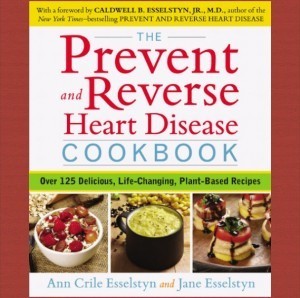
Book is available in print, Nook, Kindle and iBooks
Book releases on 9/2/14
No related posts.
July 24, 2014
Skip the Fancy Drinks, Chew Your Food
Skip the Fancy Drinks, Chew Your Food
Smoothies and juicing have been growing in popularity over the past few years. Bright juices and blended smoothies can be spotted in the hands of many celebrities and public figures. Green juices and green smoothies are thought to go hand in hand with a healthy lifestyle. From coffee shops, to grocery stores, and even to restaurants, these drinks are served almost everywhere! The colorful beverages are often featured in healthy lifestyle magazines, blogs, and infomercials. I’ve even discovered some grocery stores that are starting to carry fruits and vegetables solely for the purpose of juicing.
Both my parents and my grandparents were really into juicing when I was younger. I can remember helping to put the fruits and veggies into the machine and being mesmerized by the hue of the flowing juice. At that point, we all believed that the fruit and vegetable juice was the key to optimal health.
Due to the amount of fruits and vegetables used, juices and smoothies seem like they would be really good for you. Many people make smoothies or juice their fruits and vegetables because they feel as though when they do, they get all of their servings and benefits for the day. Often times, these drinks are made to disguise the taste of fruits or vegetables. By popping them in the juicer, plain fruits and veggies might taste more appetizing or at least they know that they’ll be able to quickly drink it.
A huge benefit we expect to be getting from our fruits and vegetables is fiber. A few the benefits of fiber include reaching a healthy weight, lowering cholesterol levels, controlling blood sugar levels, and keeping your digestive system regular. Fiber is found in a variety of foods including whole grains, beans, vegetables, and fruits—the foundation of a plant-strong diet!
All juicers work in the same way and it’s no secret that the juicer separates the fiber from the juice. All of the pulp in the little basket that you end up throwing away is the fiber. Smoothies, unlike juices, contain the entire fruit so the fiber is not removed. Instead, the metal blades of the machine disrupt the fiber. The fiber is actually what we want to be consuming, not throwing away or disrupting!
A few years ago, I made a green smoothie nearly every day. I crammed my blender with some fruit and as many greens as the container would allow, threw the lid on, and watched it swirl into a color that somewhat resembled green. Like many people, I thought I was doing myself a favor by overflowing the blender with greens because, surely, I couldn’t sit down and eat the same amount.
It wasn’t until I read Rip’s book, My Beef With Meat, that I stopped drinking smoothies. Like most people, I was unaware of the benefits of chewing your food. It sounds so simple, chewing your food, doesn’t it? Unfortunately, in today’s fast-paced world, it seems as though everything is made and marketed for quick eating.
In his book, Prevent and Reverse Heart Disease, Dr. Esselstyn places special emphasis on the lining of the heart and blood vessels—the endothelium:
“The endothelial cells make nitric oxide, which is critical to preserving the tone and health of the blood vessels. Nitric oxide is a vasodilator: that is, it causes the vessels to dilate or enlarge. When there is abundant nitric oxide in the bloodstream, it keeps blood flowing as if the vessels’ surfaces were coated with the most slippery Teflon, eliminating the stickiness of vessels and blood cells that is caused by high lipid levels and that, in turn, leads to plaque formation.” (p. 38-39)
Dr. Esselstyn knows how important it is to eat your greens. In fact, he advises his patients to chew 6 handfuls of cooked green leafy vegetables a day. The action of chewing the greens eventually creates nitric oxide. Swallowing green smoothies made with blended up greens is simply not the same as chewing them. By drinking juices and smoothies, we miss the health benefits of chewing our food. By removing and disrupting the fiber, smoothies and juices become simple sugars (or simple carbohydrates). Drinking a juice or smoothie injures the endothelial lining because the simple sugars are rapidly absorbed. A common goal all diabetics work towards is keeping their blood glucose levels stable. Dramatic increases or decreases in blood glucose levels are cause for concern and not favorable. Triglycerides also respond to these simple sugars by significantly increasing.
In the end, it all comes down to where you are in your journey. Enjoying an occasional plant-strong smoothie or juice is really not a big deal. Having a glass every once in a while or for a treat is much different from slurping one down everyday as a meal replacement. Don’t be fooled the next time you step foot inside a grocery store or coffee shop and see the display of colorful juices. Skip the fancy drinks and chew your food!
-Katherine
Resources:
Fiber: http://www.mayoclinic.org/fiber/ART-2...
Dr. Esselstyn Q&A: http://www.heartattackproof.com/qanda...
Prevent and Reverse Heart Disease by Dr. Caldwell B. Esselstyn, Jr., M.D.
No related posts.




